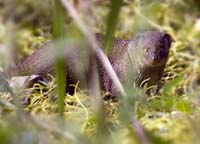| Encyclopedia of Tours and Travel to West Bengal, featuring information on Fairs & Festivals, Wildlife, Excursion, Adventure and Weather of West Bengal. |
 |
 |
 |
 |
 |
 |
 |
||
|
Wildlife
Owns the land ruled by 269 Royals. West Bengal’s wild life offers a fascinating diversity of terrain, flora and fauna. It is a delight for nature lovers. It is the home to the World Heritage Site – Sunderbans. Sunderbans - A World Heritage Site A World Heritage Site (awarded by UNESCO in ’97) that evokes the feeling of an animal lover in you. Where after a close encounter with the wild you can spend the adventurous night in the launch under the shooting stars. Situated on the lower end of the Gangetic West Bengal, 22.00° N – 89.00° E, is this world’s largest delta covered by mangrove forest and vast saline mud flats. A land of 54 tiny islands, crisscrossed by innumerable tributaries of Ganga, that was once infested by Arakanese and Portuguese pirates is now the abode of varied flora & fauna population. An area of 9630 sq. km., where 70 percent is under saline water makes the life of commoners, mostly honey-catchers, prawn-catchers and fishermen, very difficult. This is Sunderbans, the world’s largest estuarine forest. The undiscovered greenery A land ruled by 269 Royals Sunderbans is the breeding ground of immense variety of birds like Heron, Egret, Cormorant, Fishing Eagle, White Bellied Sea Eagle, Seagul, Tern, Kingfisher as well as migratory birds like Whimprel, Black-tailed Godwit, Little Stint, Eastern Knot, Curlew, Sandpiper, Golden Plover, Pintail, White-eyed Pochard and also Whistling teal. Come and discover wide variety of aquatic and reptile life forms that include Olive Ridley sea turtle, hardshelled Batgur Terrapin, Pythons, King cobra, Chequered killback, Monitor and lizards including the Salvator lizards. Best Season The D Imagine a stretch of land 130 km. long by 48 km. wide where nature has lavished all her bounties. And you know it’s Dooars. Here, an unending stretch of virgin forests is crisscrossed by the river Teesta and her innumerable tributaries. Beautiful motorable roads cut through deep forests, rich with wildlife. Mauve hills stand at the end of velvet green plains. The forests echo with the melody of birds. In between, there are fabulous wildlife sanctuaries with picture-postcard, log cabin lodges and valleys carpeted with tea gardens. Jaldapara River Toorsa runs through the Sanctuary. The forest is mainly savannah covered with tall elephant grasses. The wild life, in addition to one-horned rhinos, consists of Royal Bengal Tigers, wild elephants, deers, sambhar, barking deer, spotted deer and hog deer, wild pig, bisons and a number of birds, peafowls. Elephant ride is arranged for viewing of wild life preferably at dawn. Nestled in the heart of the picturesque Dooars, is the habitat of the rare one-horned rhinoceros, the mighty bison, the spotted deer, the barking deer, huge tuskers, fearsome wild boars and a variety of birds and animals. Elephant safaris can be enjoyed at the Sanctuary. Best Time To Visit
Buxar Tiger Reserve Best Time To Visit : November to April Singalila National Park The park hordes a variety of rare and important medicinal plants like Aconitum spp., Vaccinium spp., Swertia Chirata, Iris spp., Acorus spp., Aralia Pseudoginseng, Meconopsis spp. There exist a varity of orchids in the park some of which are Satyrium spp., Pleione Kumilis, Rhynchostylis spp., Coelogyne spp. etc. During the post monsoon season a varity of wild flowers are in room like Primulas, Geraniums, Saxifraga, Bistora, Senecio, Cotoneaster etc. The park has major mammalian fauna like the Red Panda, Himalayan Black Beer, Leopard Cat, Clouded Leopard, Barking Deer, Serow, Yellow Throated Marten, Wild Boar, Himalayan Mouse Hair. The park is very rich in avifauna and has many interesting galliform specis like the Satyr Tragopan, Kaleej Pheasant, Blood Pheasant and the Red Brested Hill Patridge. Besides this birds of all shapes, sizes, colors and hues have their homes in this park. Singali National Park is one of the most popular trekking zones in West Bengal. Two popular tourist season can be distinguished, one in the spring during March - April - May and the other in the pre - winter months beginning in September to early December. Tourist mainly visit the area for the unique view of the mountain ranges including the famous Kanchendzongha and its whole range and also the mount Everest ranges which can be viewed on clear days from Sandakphu and Phalut. Best Season Mahananda W This sanctuary is the home of Harbivores both large and small and carnivores both greater and lesser. Any visitor may be taken by surprise by a mighty lonely tusker standing on his way to Golaghat or a small herd of this Pachyderm leisurely making way for him. Open glades or grass lands may occasionaly bring out rippealed muscles of Gour or Indian Bison glistening in sunrays against the backdrop of wet mixed forests. Birds of all shapes and sizes and hues have their home in this Sanctuary. Peacock - The National Bird displaying it's colorful plumes in the right mood is quiet a common sight; the Red Jungle Fowl making a flurrying escape may quite often surprise a visitor. Parties of Scarlet Minivets fly restlessly amongst the canopy foliage and draw lines of red and yellow through them. Loud scraping sounds of a big bird in flight give out the presence of the Great Pied Hornbill, Eagles, Orioles, Shrikes, Drongoes, Magpies make bird watching a pleasurable past time for the nature lovers. Best season for visit
|
||||||||||
|
||||||||||
|
||||||||||
|---|---|---|---|---|---|---|---|---|---|---|

 ooars
ooars
 Wild Life Sanctuary situated in Alipurduar Sub-Division of Jalpaiguri
District in West Bengal is about 124 km from Siliguri. This sanctuary
was constituted in the year 1941 for the protection of Wild Life,
particularly one-horned rhinos, an animal threatened with extinction.
Wild Life Sanctuary situated in Alipurduar Sub-Division of Jalpaiguri
District in West Bengal is about 124 km from Siliguri. This sanctuary
was constituted in the year 1941 for the protection of Wild Life,
particularly one-horned rhinos, an animal threatened with extinction. National
Park located on the north-western border of Darjeeling District
of West Bengal, with the state of Sikkim on its northern boundary
and Nepal on its West. A motorable road from the nearest town of
Moneybhanjyang to Phalut serves as an internation border between
Nepal and India. Singalila National Park extends within an altitudinal
range of 2400-3636 Mts. covering an area of 78 sq. km.
National
Park located on the north-western border of Darjeeling District
of West Bengal, with the state of Sikkim on its northern boundary
and Nepal on its West. A motorable road from the nearest town of
Moneybhanjyang to Phalut serves as an internation border between
Nepal and India. Singalila National Park extends within an altitudinal
range of 2400-3636 Mts. covering an area of 78 sq. km. ildlife
Sanctuary
ildlife
Sanctuary